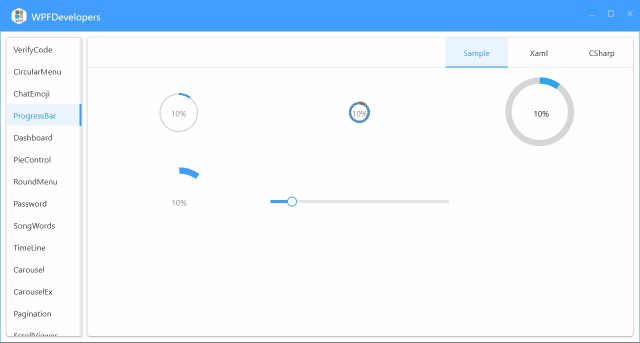-
框架使用 .NET40; -
Visual Studio 2019; -
CircularProgressBar继承ProgressBar,在XAML中创建两个Path的Data设置ArcSegment修改第二个控件的Point,设置StartPoint = new Point(Size.Width, 0)设置起点。 -
创建依赖属性 Angle作为修改ArcSegment的Point作为进度条的圆的闭合。 -
当进度条 ValueChanged时创建DoubleAnimation动画,修改Angle。.
1) CircularProgressBar.xaml 代码如下:
<ResourceDictionary xmlns="http://schemas.microsoft.com/winfx/2006/xaml/presentation"
xmlns:x="http://schemas.microsoft.com/winfx/2006/xaml"
xmlns:controls="clr-namespace:WPFDevelopers.Controls"
xmlns:convert="clr-namespace:WPFDevelopers.Converts">
<ResourceDictionary.MergedDictionaries>
<ResourceDictionary Source="Basic/ControlBasic.xaml"/>
</ResourceDictionary.MergedDictionaries>
<convert:AngleToPointConverter x:Key="prConverter"/>
<convert:AngleToIsLargeConverter x:Key="isLargeConverter"/>
<Style TargetType="{x:Type controls:CircularProgressBar}" BasedOn="{StaticResource ControlBasicStyle}">
<Setter Property="Maximum" Value="100"/>
<Setter Property="StrokeThickness" Value="10"/>
<Setter Property="Foreground" Value="{DynamicResource InfoSolidColorBrush}"/>
<Setter Property="Background" Value="{DynamicResource PrimaryNormalSolidColorBrush}"/>
<Setter Property="HorizontalAlignment" Value="Center"/>
<Setter Property="VerticalAlignment" Value="Center"/>
<!--<Setter Property="Width" Value="100"/>
<Setter Property="Height" Value="100"/>-->
<Setter Property="Template">
<Setter.Value>
<ControlTemplate TargetType="{x:Type controls:CircularProgressBar}">
<controls:SmallPanel Width="{Binding ElementName=PART_Path,Path=ActualWidth}"
Height="{Binding ElementName=PART_Path,Path=ActualHeight}"
HorizontalAlignment="{TemplateBinding HorizontalAlignment}"
VerticalAlignment="{TemplateBinding VerticalAlignment}">
<Canvas>
<Path Stroke="{TemplateBinding BorderBrush}"
StrokeThickness="{TemplateBinding BrushStrokeThickness}"
x:Name="PART_Path">
<Path.Data>
<PathGeometry>
<PathFigure x:Name="PART_PathFigure">
<ArcSegment SweepDirection="Clockwise"
IsLargeArc="True"
x:Name="PART_ArcSegment">
</ArcSegment>
</PathFigure>
</PathGeometry>
</Path.Data>
</Path>
<Path Stroke="{TemplateBinding Background}"
StrokeThickness="{TemplateBinding StrokeThickness}">
<Path.Data>
<PathGeometry>
<PathFigure x:Name="PART_PathFigureAngle">
<ArcSegment SweepDirection="Clockwise"
IsLargeArc="{Binding Path=Angle, Converter={StaticResource isLargeConverter}, RelativeSource={RelativeSource FindAncestor, AncestorType=ProgressBar}}"
x:Name="PART_ArcSegmentAngle">
<ArcSegment.Point>
<MultiBinding Converter="{StaticResource prConverter}">
<Binding Path="Angle" RelativeSource="{RelativeSource FindAncestor, AncestorType=ProgressBar}"/>
<Binding Path="Size" RelativeSource="{RelativeSource FindAncestor, AncestorType=ProgressBar}"/>
</MultiBinding>
</ArcSegment.Point>
</ArcSegment>
</PathFigure>
</PathGeometry>
</Path.Data>
</Path>
</Canvas>
<TextBlock Foreground="{TemplateBinding Foreground}"
Text="{Binding Path=Value, StringFormat={}{0}%,
RelativeSource={RelativeSource TemplatedParent}}"
FontSize="{TemplateBinding FontSize}"
VerticalAlignment="Center"
HorizontalAlignment="Center"
x:Name="PART_TextBlock"/>
</controls:SmallPanel>
</ControlTemplate>
</Setter.Value>
</Setter>
</Style>
</ResourceDictionary>
2) CircularProgressBar.xaml.cs 代码如下:
using System;
using System.Windows;
using System.Windows.Controls;
using System.Windows.Media;
using System.Windows.Media.Animation;
namespace WPFDevelopers.Controls
{
[TemplatePart(Name = ArcSegmentTemplateName, Type = typeof(ArcSegment))]
[TemplatePart(Name = ArcSegmentAngleTemplateName, Type = typeof(ArcSegment))]
[TemplatePart(Name = PathFigureTemplateName, Type = typeof(PathFigure))]
[TemplatePart(Name = PathFigureAngleTemplateName, Type = typeof(PathFigure))]
[TemplatePart(Name = TextBlockTemplateName, Type = typeof(TextBlock))]
public class CircularProgressBar : ProgressBar
{
private const string ArcSegmentTemplateName = "PART_ArcSegment";
private const string ArcSegmentAngleTemplateName = "PART_ArcSegmentAngle";
private const string PathFigureTemplateName = "PART_PathFigure";
private const string PathFigureAngleTemplateName = "PART_PathFigureAngle";
private const string TextBlockTemplateName = "PART_TextBlock";
private ArcSegment _arcSegment, _arcSegmentAngle;
private PathFigure _pathFigure, _pathFigureAngle;
private TextBlock _textBlock;
public static readonly DependencyProperty SizeProperty =
DependencyProperty.Register("Size", typeof(Size), typeof(CircularProgressBar),
new PropertyMetadata(new Size(50,50)));
public static readonly DependencyProperty AngleProperty =
DependencyProperty.Register("Angle", typeof(double), typeof(CircularProgressBar),
new PropertyMetadata(0.0));
public static readonly DependencyProperty StrokeThicknessProperty =
DependencyProperty.Register("StrokeThickness", typeof(double), typeof(CircularProgressBar),
new PropertyMetadata(10.0));
public static readonly DependencyProperty BrushStrokeThicknessProperty =
DependencyProperty.Register("BrushStrokeThickness", typeof(double), typeof(CircularProgressBar),
new PropertyMetadata(1.0));
public CircularProgressBar()
{
ValueChanged += CircularProgressBar_ValueChanged;
}
public override void OnApplyTemplate()
{
base.OnApplyTemplate();
if (Size.Width != Size.Height)
{
var max = Math.Max(Size.Width, Size.Height);
Size = new Size(max, max);
}
_pathFigure = GetTemplateChild(PathFigureTemplateName) as PathFigure;
_pathFigureAngle = GetTemplateChild(PathFigureAngleTemplateName) as PathFigure;
_pathFigure.StartPoint = new Point(Size.Width, 0);
_pathFigureAngle.StartPoint = new Point(Size.Width, 0);
_arcSegment = GetTemplateChild(ArcSegmentTemplateName) as ArcSegment;
_arcSegment.Size = Size;
_arcSegment.Point = new Point(Size.Width - 0.000872664626, 7.61543361704753E-09);
_arcSegmentAngle = GetTemplateChild(ArcSegmentAngleTemplateName) as ArcSegment;
_arcSegmentAngle.Size = Size;
_textBlock = GetTemplateChild(TextBlockTemplateName) as TextBlock;
if (Size.Width < 15)
{
FontSize = 8;
}
}
public Size Size
{
get => (Size)GetValue(SizeProperty);
set => SetValue(SizeProperty, value);
}
public double Angle
{
get => (double)GetValue(AngleProperty);
set => SetValue(AngleProperty, value);
}
public double StrokeThickness
{
get => (double)GetValue(StrokeThicknessProperty);
set => SetValue(StrokeThicknessProperty, value);
}
public double BrushStrokeThickness
{
get => (double)GetValue(BrushStrokeThicknessProperty);
set => SetValue(BrushStrokeThicknessProperty, value);
}
private void CircularProgressBar_ValueChanged(object sender, RoutedPropertyChangedEventArgs<double> e)
{
var bar = sender as CircularProgressBar;
var currentAngle = bar.Angle;
var targetAngle = e.NewValue / bar.Maximum * 359.999;
var anim = new DoubleAnimation(currentAngle, targetAngle, TimeSpan.FromMilliseconds(500));
bar.BeginAnimation(AngleProperty, anim, HandoffBehavior.SnapshotAndReplace);
}
}
}
3) AngleToPointConverter.cs 代码如下:
using System;
using System.Globalization;
using System.Windows;
using System.Windows.Data;
namespace WPFDevelopers.Converts
{
internal class AngleToPointConverter : IMultiValueConverter
{
public object Convert(object[] values, Type targetType, object parameter, CultureInfo culture)
{
var angle = (double)values[0];
var size = (Size)values[1];
var radius = (double)size.Height;
var piang = angle * Math.PI / 180;
var px = Math.Sin(piang) * radius + radius;
var py = -Math.Cos(piang) * radius + radius;
return new Point(px, py);
}
public object[] ConvertBack(object value, Type[] targetTypes, object parameter, CultureInfo culture)
{
throw new NotImplementedException();
}
}
}
4) AngleToIsLargeConverter.cs 代码如下:
using System;
using System.Globalization;
using System.Windows.Data;
namespace WPFDevelopers.Converts
{
internal class AngleToIsLargeConverter : IValueConverter
{
public object Convert(object value, Type targetType, object parameter, CultureInfo culture)
{
var angle = (double)value;
return angle > 180;
}
public object ConvertBack(object value, Type targetTypes, object parameter, CultureInfo culture)
{
throw new NotImplementedException();
}
}
}
5) CircularMenuExample.xaml 代码如下:
<UserControl x:Class="WPFDevelopers.Samples.ExampleViews.CircularMenuExample"
xmlns="http://schemas.microsoft.com/winfx/2006/xaml/presentation"
xmlns:x="http://schemas.microsoft.com/winfx/2006/xaml"
xmlns:mc="http://schemas.openxmlformats.org/markup-compatibility/2006"
xmlns:d="http://schemas.microsoft.com/expression/blend/2008"
xmlns:local="clr-namespace:WPFDevelopers.Samples.ExampleViews"
xmlns:wpfdev="https://github.com/WPFDevelopersOrg/WPFDevelopers"
xmlns:controls="clr-namespace:WPFDevelopers.Samples.Controls"
mc:Ignorable="d"
d:DesignHeight="450" d:DesignWidth="800">
<controls:CodeViewer>
<StackPanel Background="Black">
<TextBlock Text="微信公众号:WPFDevelopers" FontSize="40"
Foreground="#A9CC32" FontWeight="Bold"
Margin="50,10,0,20"/>
<wpfdev:CircularMenu ItemsSource="{Binding MenuArray,RelativeSource={RelativeSource AncestorType=local:CircularMenuExample}}"
SelectionChanged="CircularMenu_SelectionChanged"/>
</StackPanel>
<controls:CodeViewer.SourceCodes>
<controls:SourceCodeModel
CodeSource="/WPFDevelopers.SamplesCode;component/ExampleViews/CircularMenuExample.xaml"
CodeType="Xaml"/>
<controls:SourceCodeModel
CodeSource="/WPFDevelopers.SamplesCode;component/ExampleViews/CircularMenuExample.xaml.cs"
CodeType="CSharp"/>
</controls:CodeViewer.SourceCodes>
</controls:CodeViewer>
</UserControl>

参考资料
